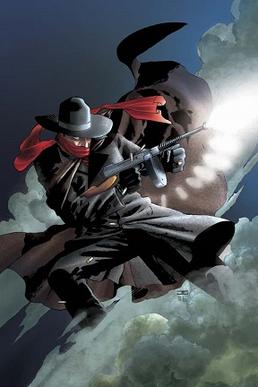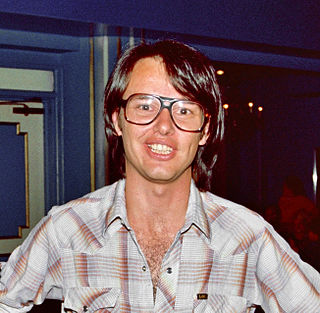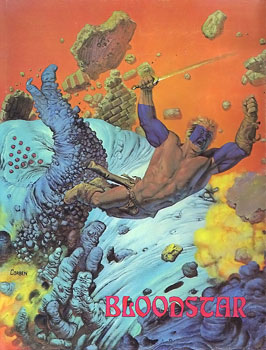
A graphic novel is a long-form, fictional work of sequential art. The term graphic novel is often applied broadly, including fiction, non-fiction, and anthologized work, though this practice is highly contested by comics scholars and industry professionals. It is, at least in the United States, typically distinct from the term comic book, which is generally used for comics periodicals and trade paperbacks.

The Shadow is a fictional character published in the United States of America by magazine publishers Street & Smith and writer Walter B. Gibson. Originally created to be a mysterious radio show narrator, and developed into a distinct literary character in 1931 by writer Walter B. Gibson, The Shadow has been adapted into other forms of media, including American comic books, comic strips, serials, video games, and at least five feature films. The radio drama included episodes voiced by Orson Welles.

James F. Steranko is an American graphic artist, comic book writer/artist, comics historian, magician, publisher and film production illustrator.

Robert Kane was an American comic book writer, animator and artist who co-created Batman and most early related characters for DC comics. He was inducted into the comic book industry's Jack Kirby Hall of Fame in 1993 and into the Will Eisner Comic Book Hall of Fame in 1996.

Star Reach was an American science fiction and fantasy comics anthology published from 1974 to 1979 by Mike Friedrich.

Byron Preiss was an American writer, editor, and publisher. He founded and served as president of Byron Preiss Visual Publications, and later of ibooks Inc. Many of his projects were in the forms of graphic novels, comics, illustrated books, and children's books. Beyond traditional printed books, Preiss frequently embraced emerging technologies, and was recognized as a pioneer in digital publishing and as among the first to publish in such formats as CD-ROM books and ebooks.
Ralph Reese is an American artist who has illustrated for books, magazines, trading cards, comic books and comic strips, including a year drawing the Flash Gordon strip for King Features. Prolific from the 1960s to the 1990s, he is best known for his collaboration with Byron Preiss on the continuing feature "One Year Affair", serialized in the satiric magazine National Lampoon from 1973 to 1975 and then collected into a 1976 book.

Mike Friedrich is an American comic book writer and publisher best known for his work at Marvel and DC Comics, and for publishing the anthology series Star*Reach, one of the first independent comics. He is also an artists' representative.

Dean Motter is an illustrator, designer and writer who has worked for many years in Canada (Toronto) and the United States. He is best known for his album cover designs, two of which won Juno Awards. He is also the creator and designer of Mister X, one of the most influential "new-wave" comics of the 1980s.

Bloodstar is an American fantasy comic book published in 1976. Possibly the first graphic novel to call itself a “graphic novel” in print, it was based on a short story by Robert E. Howard, the creator of Conan the Barbarian, and illustrated by fantasy artist Richard Corben. The book was published by The Morning Star Press in a limited signed and numbered edition.

Blackmark is a paperback book published by the American company Bantam Books in January 1971. It is one of the first American graphic novels, predating works such as Richard Corben's Bloodstar (1976), Jim Steranko's Chandler: Red Tide (1976), Don McGregor and Paul Gulacy's Sabre, and Will Eisner's A Contract with God. It was conceived and drawn by comic book artist Gil Kane, and scripted by Archie Goodwin from an outline by Kane.
Weird Heroes, subtitled "New American Pulp", was an American series of novels and anthologies produced by Byron Preiss in the 1970s that dealt with new heroic characters inspired by pulp magazine characters.
Jove Books, formerly known as Pyramid Books, is an American paperback and eBook publishing imprint, founded as an independent paperback house in 1949 by Almat Magazine Publishers. The company was sold to the Walter Reade Organization in the late 1960s. It was acquired in 1974 by Harcourt Brace which renamed it to Jove in 1977 and continued the line as an imprint. In 1979, they sold it to The Putnam Berkley Group, which is now part of the Penguin Group.
Fiction Illustrated is a short-lived series of early illustrated fiction, similar to graphic novels, produced and packaged by Byron Preiss Visual Productions in the 1970s and published by Pyramid/Jove/HBJ. Four were produced, with a fifth was planned. All but one were written by Byron Preiss. The first three were published digest size, the fourth was published in larger format.
Ken Bruzenak is an American comic book letterer, primarily known for his work on Howard Chaykin’s American Flagg! Bruzenak's lettering and logowork was integral to the comic's futuristic, trademark-littered ambience. During the course of his career, Bruzenak has been closely associated with both Chaykin and Jim Steranko.

This is a list of works by Jim Steranko.

Empire is a 1978 graphic novel written by Samuel R. Delany and illustrated by Howard Chaykin.

Polar is a 2012 webcomic and series of graphic novels written and illustrated by Spanish cartoonist Victor Santos. Featuring "international hitman Black Kaiser", the webcomic is inspired by a variety of action and noir fiction. Polar is characterized by its highly stylized design and complete lack of dialogue, though speech balloons were added in the graphic novel publications by Dark Horse Comics. A live-action film based on the webcomic premiered on Netflix in January 2019.
National Comics Publications and All-American Publications, two precursors to DC Comics, were formed publishing American comic books such as superhero comics starting in the 1930s. Primary Comic book anthology titles created by the company was More Fun Comics, Adventure Comics, Detective Comics, Action Comics, All-American Comics and Superman. Other companies like Quality Comics and Fawcett Comics would later be merged into DC. Quality started by introducing comic books like Feature Comics and Smash Comics.
Comics packaging is a publishing activity in which a publishing company outsources the myriad tasks involved in putting together a comic book — writing, illustrating, editing, and even printing — to an outside service called a packager. Once the comics packager has produced the comic, they then sell it to the final publishing company.














